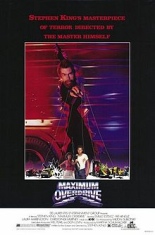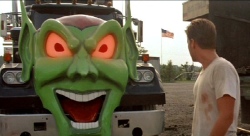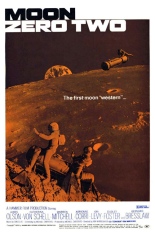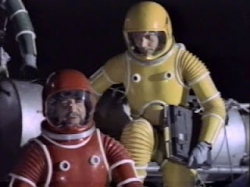
 Although he’s second-billed, Jim Hutton (TV’s Ellery Queen) plays Arnold Masters, the Psychic Killer in question. Wearing red-rimmed glasses that likely make him the least popular man behind bars, he’s institutionalized for a murder he swears he did not commit. And he didn’t. But give the man some time.
Although he’s second-billed, Jim Hutton (TV’s Ellery Queen) plays Arnold Masters, the Psychic Killer in question. Wearing red-rimmed glasses that likely make him the least popular man behind bars, he’s institutionalized for a murder he swears he did not commit. And he didn’t. But give the man some time.
After a fellow mental patient commits suicide, Arnold learns the man willed him some sort of voodoo necklace, which enables him to astral-project into others’ bodies and do some crimes. Once the murder charges are dropped and Arnold his free, he uses his new jewelry as often as a teenage boy does erections.
 Anyone responsible for the death of his mother and his wrongful imprisonment are at the top of Arnold’s shit list. A rapey doctor goes kablooey; a hot nurse is scalded to death in the shower, as its head cranes to follow her around the tight space; a cop drives his car off a cliff; a contractor is smashed by a cement block; a butcher is chased by slabs of meat until he gets caught in a machine that turns him into ground round. It’s tough not to think of the Final Destination series since the culprit is nowhere present at these grisly deaths.
Anyone responsible for the death of his mother and his wrongful imprisonment are at the top of Arnold’s shit list. A rapey doctor goes kablooey; a hot nurse is scalded to death in the shower, as its head cranes to follow her around the tight space; a cop drives his car off a cliff; a contractor is smashed by a cement block; a butcher is chased by slabs of meat until he gets caught in a machine that turns him into ground round. It’s tough not to think of the Final Destination series since the culprit is nowhere present at these grisly deaths.
Because Hutton was such a likable actor — or perhaps I’m just a sick bastard — I was rooting for Arnold, and not for the gruff detective (Paul Burke, Valley of the Dolls) eager to get his goat. Directed and co-written by Ray Danton (Deathmaster), the film alternates between police procedural and speculative fiction, with some surprising gore sprinkled about, and topped with one of the screen’s oddest stripteases (courtesy of Love Me Deadly’s Mary Wilcox). Yet for some reason, it doesn’t feel like a mess; it feels like an undiscovered gem of weirdo ’70s cinema. —Rod Lott








